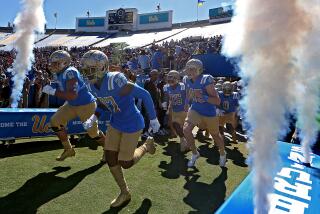Fences Being Built at Three Cup Sites : Soccer: RFK, Cotton Bowl and Stanford going against organizing committee’s wishes.
- Share via
Concerns about security problems during the World Cup have prompted three venues to defy the wishes of the World Cup Organizing Committee and soccer’s international governing body and erect fencing between stadium seating areas and the playing fields.
In a conference call Thursday, World Cup chairman Alan Rothenberg again emphasized that chain-link fences to keep fans off the playing fields would not be necessary during the World Cup finals, which begin June 17. In fact, he said, fences ringing a field could lead to injuries from fans being crushed against them.
Nevertheless, local police at three of the nine World Cup venues have overruled Rothenberg and FIFA, soccer’s international authority, and have begun installing fences at RFK Stadium in Washington, the Cotton Bowl in Dallas and Stanford Stadium in Palo Alto.
Because of crowd-control problems in Europe and elsewhere, fences commonly have been used in soccer to keep fans from rushing the field. But the recent trend has been to remove the fences. Tragedies such as the Heysel Stadium disaster in Brussels in 1985 drew attention to the potential for danger. In that game, 38 fans suffocated or were crushed to death when a fence separating rival fan groups collapsed.
FIFA has taken a strong stand against fences. Joseph Blatter, the general secretary of FIFA, has said, “Animals in a zoo belong behind fences, not people.”
This World Cup offers a unique logistics problem: Seating areas in American stadiums tend to be closer to the playing fields, thus not allowing a buffer zone between fans and players. In addition, soccer fields are longer and wider than football fields. In many of the stadiums that will be used in this year’s tournament, the playing area extends to the edge of the stands.
World Cup officials had considered fencing or plexiglass barriers but rejected that idea. In some venues, such as the Rose Bowl, the same effect will be achieved by cutting back seats, mainly for sight-line considerations. At the Rose Bowl, the first 10 rows of seats in the end zones and the first six on the sidelines will not be sold. Those seats will be draped with tarps.
“We think that the correct plan is to remove fences,” Rothenberg said. “Our concern in the United States is not people rushing the playing field to do harm to the players or officials. Our concern is an exuberant fan rushing down to celebrate. Our concern is that in the mad rush to get down there, people will get crushed against a fence.”
*
In other World Cup news, the World Cup Organizing Committee has agreed on a policy regarding the sale of alcohol during games.
The issue had come to the fore when Rothenberg sent a letter last month to the mayors of the nine venue cities, asking for alcohol bans on game days. During the 1990 World Cup in Italy, some cities instituted alcohol bans on game days to prevent security problems caused by drunken fans.
The guidelines, which were completed Monday but have yet to be announced, recognize that the final decisions regarding alcohol sales can be made only by stadium management and local authorities.
The World Cup guidelines:
--A two-beer maximum per person.
--Serving sizes of no larger than 12 ounces.
--No sales by vendors in the seating areas.
--No alcohol sales sooner than 90 minutes before game time.
--No alcohol sales after halftime.
--Suspension of sales when it is determined that fans are drinking excessively or the mood of the crowd is becoming dangerous.
David Simmons, World Cup venue executive director at the Rose Bowl, said he submitted the proposal to the city of Pasadena on Thursday and had not received a response.
“The city has the right to control alcohol,” he said. “Early indications are that they will say no and not allow us to sell alcohol in the licensed premises.”
More to Read
Go beyond the scoreboard
Get the latest on L.A.'s teams in the daily Sports Report newsletter.
You may occasionally receive promotional content from the Los Angeles Times.








